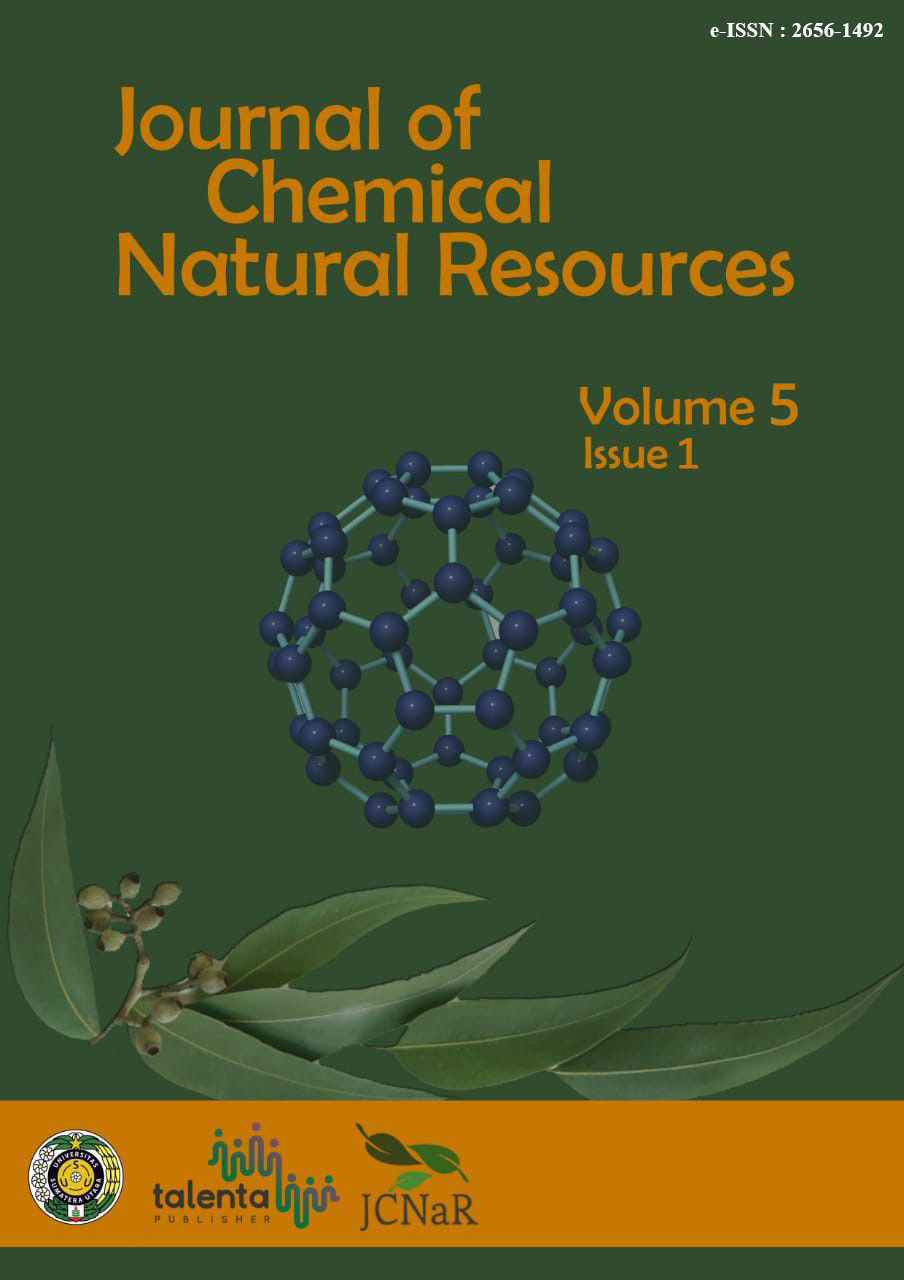Utilization of Carboxymethyl Cellulose (CMC) from Coconut Coir Waste (Cocos nucifera) as a Stabilizer in Red Bean (Phaseolus vulgaris L) Vegetable Milk
DOI:
https://doi.org/10.32734/jcnar.v5i1.11988Keywords:
Alkalizations, Carboxymethyl Cellulose, Red Bean, ViscosityAbstract
Carboxymethyl cellulose (CMC) synthesis from coconut coir waste provides an alternative that can be used as a stabilizer to manufacture red bean milk. The first step is to isolate alpha-cellulose with a 2% NaOH solution. Second, the etherification process is alkalization with isopropanol and 17.5% NaOH solution to produce alkaline cellulose, and then the carboxymethylation process with sodium monochloride acetate (NaMCA) and characterized by FT-IR. The resulting carboxymethyl cellulose is purified by centrifugation. Red bean milk was analyzed using proximate analysis, viscosity, percent stability, pH, and organoleptic content by varying CMC 0.1, 0.2, and 0.5%. The alpha cellulose obtained was 13.37%, and the CMC produced from the etherification and purification process was 5.97 g. The characterization of alpha-cellulose showed (OH) at wave number 3441cm-1, and the CMC characterization showed carbonyl (COO-) at wave number 1604.77 cm-1 and group ether (CH2-O-CH2) at wave number 1419.77. Proximate analysis of red bean milk protein content of 2.75%, carbohydrates 10.27%, fiber 8.5%, and fat 18.57% and results based on viscosity and percent stability were obtained by adding 0.5% CMC and organoleptic test results adding CMC preferably with 0.3%, the texture is not too thick and even, and the aroma of red beans is typical.
Downloads
References
Lumintang RCA, Soenoko R, and Wahyudi, S. 2011. Composite Hybrid Polyester with Stem Powder and Coconut Coir Fiber Reinforcement. Mechanical Engineering Journal. 2(2)
Mulyawan M, Setyowati E, and Widjaja A. 2015. Sodium Ligno Sulfonate (SLS) Surfactant from Coconut Coir Dust. ITS Technical Journal.Vol.4. Number 1.
Rakhmatullah R. 2015. Making Carboxymethyl Cellulose from Microbial Cellulose (Nata De Cassava). Thesis. IPB.
Bagus, Prasetyo B, Purwadi and Djalal R. 2014. CMC (Carboxy Methyl Cellulose ) Addition of Guava (Psidium guajava) Cider Honey Drink Based On pH, Viscosity, Total Mold, and Organoleptic Quality. Brawijaya University Malang.
Maharani F, and Riwayani I. 2017. Analysis of Protein Content and Organoleptic Tests of Tolo Bean Milk (Vigna Unguicalata) and Red Bean Milk (Phaseulus Vulgaris L) Combined with Soybeans. ISSN. 2528-912.
Nyombair G, Siddiq M, Dolan KD. 2016. Physico Chemical and Sensory Quality of Extruded Light Red Kidney Bean ( Phaseolus vulgaris L). Porridge. Food Science and Technology. Elsevier. 44(7):1597-1602.
Ohwoavworhua Frank O, Adelakun TA and Okhamafe Agustine O. 2009. Processing Pharmaceutical grade microcrystalline cellulose from groundnut husk: Extraction methods and characterization. International Journal of Green Pharmacy.
Bono A, Ying PH, Yan FY, Muei CL, Sarbatly R, and Krishnaiah. 2009. Synthesis and Characterization of Carboxymethyl Cellulose from Palm Kernel Cake. Advances in Natural and Applied Sciences. 3(1 ); 5-11.
Hong Km. 2013. Preparation and Characterization Of Carboxymethyl Cellulose From Sugarcane Bagasse. Essays. Malaysia: Tunku Abdul Rahman University.1:21-84.
Rahman T, and Triyono, Agus. 2011. Utilization of Mung Beans (Phaseolus radiatus L) to Become Green Bean Sweetened Condensed Milk. Proceedings of SNaPP2011 Science, Technology and Health. ISSN: 2089-3582.
A Kinterinwa A, Osemeahon. S.A., Akinsola. A.F. and Reuben. U. 2014. Phsycochemical and Pasting Characterization of Carboxymetylated Scarlet Runner Bean (Phaseolus coccineus) Starch. Journal of Agriculture and Food Technology. TextRoad Publication 4(2)13-20.
Hadi, Alfian. 2014. Synthesis of Antibacterial Hydrogels Based on Carboxymethyl Cellulose-ZnSO 4 . Thesis. Bandung Institute of Technology
Nacos M, Katapodis P, Pappas C, Daffarera D, Tarantilis PA, Christakapoulus D. 2006. Kenaf Xylan-A Source of Biologically Active Acidic Oligosaccharides. Carbohydrate Polymers.66 (1 ): 126-134
Garside P, and Wyteh P. 2003. Identification of Cellulose Fibers by FTIR Spectroscopy: Thread and Single Fiber Analysis by Attenuated Total Reflectance, Studies in Conservation. 48(4 ): 269-275.
Khalil HPA, Ismail H, Rozman HD, and Ahmad, MN 2001. The Effect of Acetylation on Interfacial Shear Strength Between Plant Fiber and Various Matrices. European Polymer Journal. 37(5):1037-1045.
Alemdar A, and Sain M. 2008. Isolation and Characterization of Nanofiber from Agricultural Residue-Wheat Straw and Soy Hulls. Bioresource and Technology. 99: 164-167
Safitri D, Abdul RR, Prismawiyanti and Sikanna R. 2017. Synthesis of Carboxymethyl Cellulose Durian Peel (Durio zibhetinus). Covalent Journal. ISSN: 2477-5398.
Pescok RL, Shields LD, Caims T, and McWilliam IG. 1976. Modern Methods of Chemical Analysis New York: Willey.
Lestari P, Titi Nur H, Siti Hanum IL, Djagal Wiseso M. 2004. Development of Technology for Manufacturing High Economic Value Biopolymers From Corn Plant Waste ( Zea Mays) for Industry: CMC ( Carboxymethyl Cellulose). Thesis, Yogyakarta UGM.
Standard, 1995. Soy Milk Quality Requirements. 01-3830-199 BSN. Jakarta.
Wallace C. 2009. Sodium carboxymethyl cellulose is The Ideal Hydrocolloid for Dairy Applications. Dowwolf. Germany. Wibisono and solechudin. 2002. Practical workbook at PT Kertas. ITS Press. Surabaya
Isniawan VY, Subagyo, and Utami S. 2013. The Effect of Percentage Addition of Honey with Different Storage Time on pH and Goat's Milk AlcoholTest. Scientific Journal of Animal Husbandry 1 (1): 79-87.
Rini AKI, Dwi and Basito. 2012. The Effect of CMC Stabilizer and Gum Arabic Combination on the Quality of Velva Carrot (Daucus Carota L) Selo and Tawangmangu Varieties. Department of Agricultural Product Technology. Faculty of Agriculture, UNS, Surakarta.
Siskawardani D, Nur DK, and BH, Mohammad 2013. Effect of Na-CMC (Sodium Carboxy Methyl Cellulose) Concentration and Centrifugation Time on the Physical and Chemical Properties of Sugar Cane Juice Drinks (Saccharum Officiunaru L). Department of Agricultural Engineering. Faculty of Agricultural Technology, University of Brawijaya
Anggarini M. 2016. The Effect of Carboxymethyl Cellulose (CMC) Concentration and Long Storage Time at Cold Temperatures on the Stability and Characterization of Pineapple Juice Probiotic Drinks. Thesis. Lampung University.

Downloads
Published
Issue
Section
License
Copyright (c) 2023 Journal of Chemical Natural Resources

This work is licensed under a Creative Commons Attribution-ShareAlike 4.0 International License.














